8.8 /10 1 Votes
Cabinet Upright Initial release date 1981 | 4.4/5 Classic Retro Games Arcade system Konami Scramble Series Oretachi Gēsen Zoku | |||||||||||||||||||||||||||||||||
Genre(s) Horizontal scrolling shooter Mode(s) Up to 2 players, alternating turns Sound 2× AY-3-8910 @ 1.78975MHz Display Raster, 224 × 256, vertical orientation Platforms Arcade game, PlayStation 4, PlayStation, Xbox 360 Developers Konami, Backbone Entertainment, General Consumer Electric Publishers Konami, Stern, GCE, Milton Bradley Company, Hamster Corporation, Interceptor Micros Similar Oretachi Gēsen Zoku games, Stern games, Shoot 'em up games | ||||||||||||||||||||||||||||||||||
Scramble (スクランブル, Sukuranburu) is a 1981 side-scrolling shoot 'em up arcade game. It was developed by Konami, and manufactured and distributed by Leijac in Japan and Stern in North America. It was the first side-scrolling shooter with forced scrolling and multiple distinct levels. The Konami Scramble arcade system board hardware uses two Zilog Z80 microprocessors for the central processing unit, two AY-3-8910 sound chips for the sound, and Namco Galaxian video hardware for the graphics.
Contents
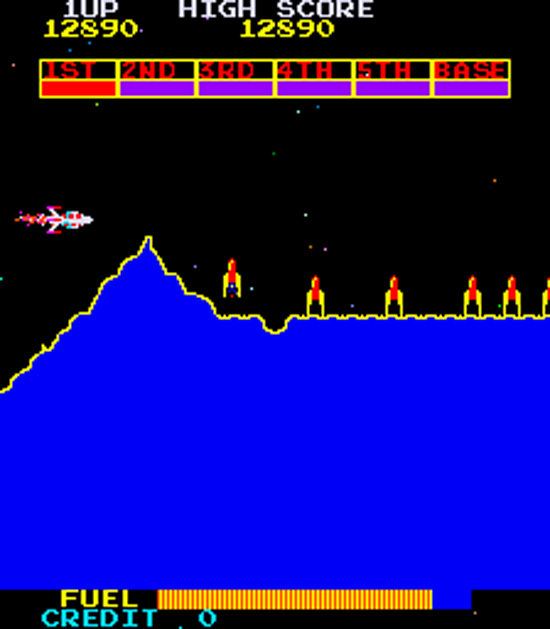
The game was a success, selling 15,136 video game arcade cabinets in the United States within five months, by August 4, 1981, becoming Stern's second best-selling game after Berzerk. Its sequel, the more difficult Super Cobra, sold 12,337 cabinets in the US in four months that same year, adding up to 27,473 US cabinet sales for both, by October 1981.
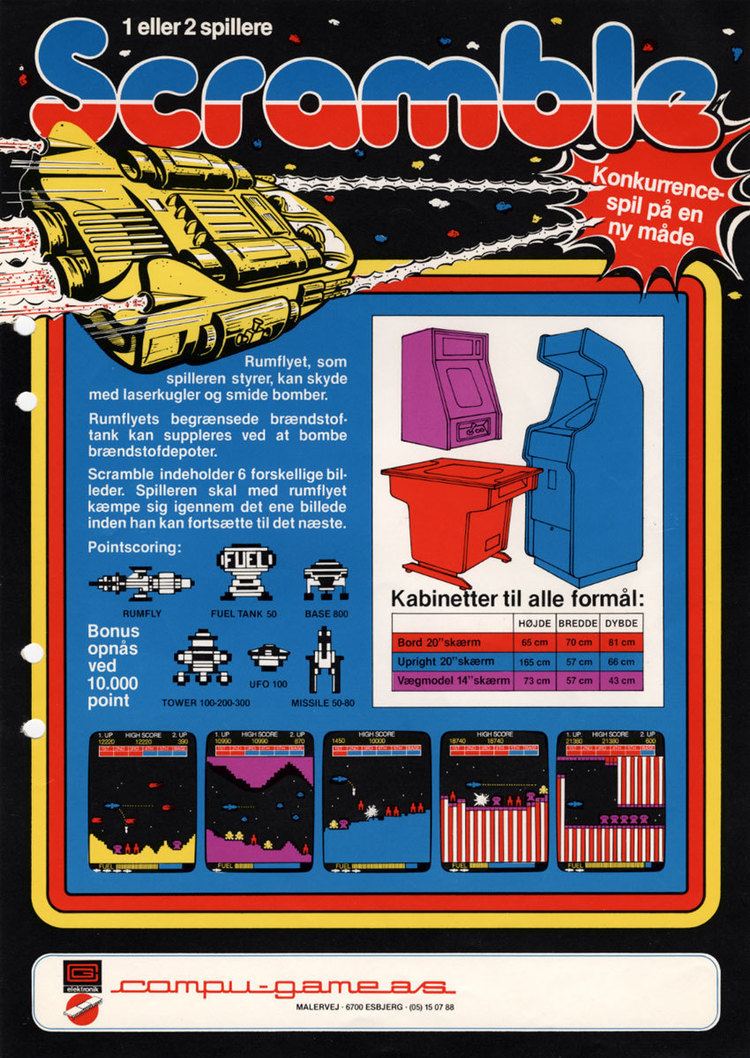
Scramble was not ported to any major contemporary consoles or computers, but there were versions for the Tomy Tutor and Vectrex. Several unauthorized clones for the VIC-20 and Commodore 64 used the same name as the original.
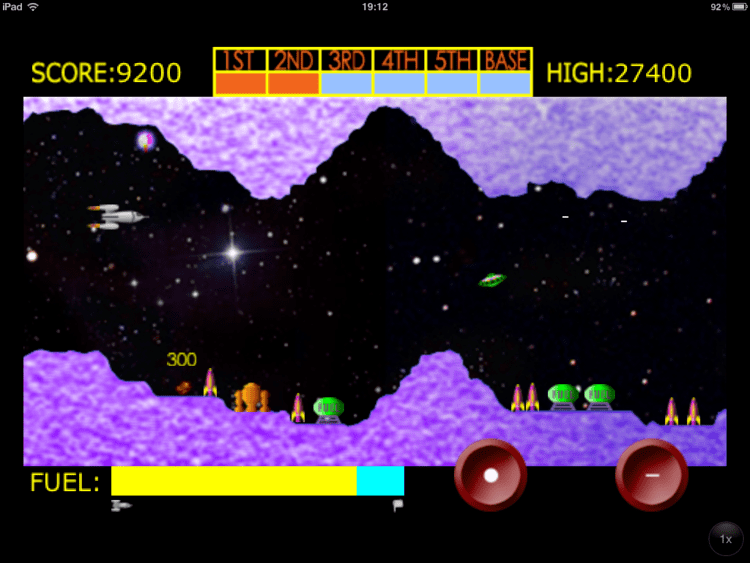
Gameplay
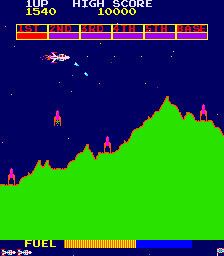
The player controls an aircraft, referred to in the game as a "Jet," and has to guide it across a scrolling terrain, battling obstacles along the way. The ship is armed with a forward-firing weapon and bombs; each weapon has its own button. The player must avoid colliding with the terrain and other enemies, while simultaneously maintaining its limited fuel supply which diminishes over time. More fuel can be acquired by destroying fuel tanks in the game.
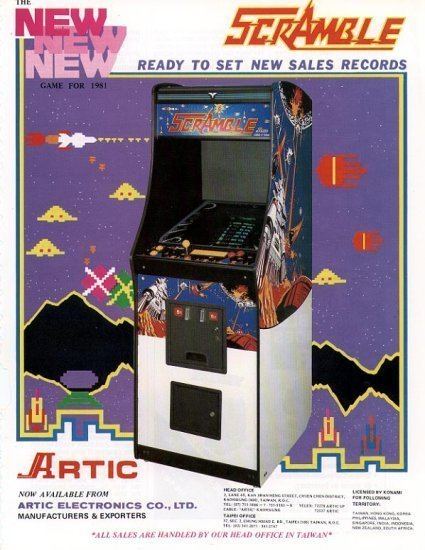
The game is divided into six sections, each with a different style of terrain and different obstacles. There is no intermission between each section; the game simply scrolls into the new terrain. Points are awarded based upon the number of seconds of being alive, and on destroying enemies and fuel tanks. In the final section, the player must destroy a "base". Once this has been accomplished, a flag denoting a completed mission is posted at the bottom right of the screen. The game then repeats by returning to the first section once more, with a slight increase in difficulty.
Scoring
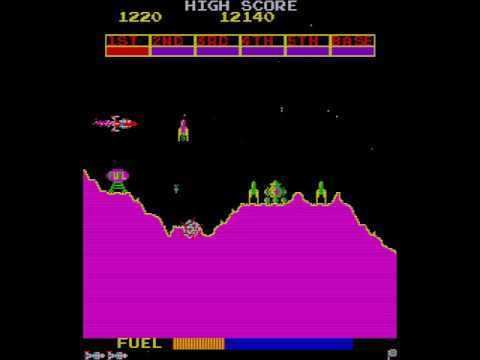
Players earn an extra life at 10,000 points, and none thereafter.
Reception and legacy
Scramble was commercially successful and critically acclaimed in its time. In its February 1982 issue, Computer and Video Games magazine said it "was the first arcade game to send you on a mission and quickly earned a big following." In 1982, Arcade Express gave the dedicated Tomytronic version of the game a score of 9 out of 10, describing it as an "engrossing" game that "rates as one of the year's best so far." The Vectrex version of the game was also praised in a review by Video magazine where reviewers praised its fidelity to the original arcade game and described it as their favorite among the Vectrex titles they had reviewed. The game's overlays were singled out for praise, with reviewers commenting that "when you're really involved with a Vectrex game like Scramble, it's almost possible to forget that the program is in black-and-white."
An electronic tabletop version of Scramble was released in 1982 in the UK by Grandstand under licence from Japanese firm Epoch Co., who sold the game in Japan under the title Astro Command. Gameplay differs from the arcade version as no scenery is rendered and the ship has no need to refuel
According to the Nintendo Game Boy Advance Gradius Advance intro and the Gradius Breakdown DVD included with Gradius V, Scramble is considered the first in the Gradius series. However, the Gradius Collection guidebook issued a few years after by Konami, lists Scramble as part of their shooting history, and the Gradius games are now listed separately.
An updated version of Scramble is available in Konami Collector's Series: Arcade Advanced by inputting the Konami Code in the game's title screen. This version allows three different ships to be chosen: the Renegade, the Shori, and the Gunslinger. The only difference between the ships besides their appearance are the shots they fire. The Renegade's shots are the same as in the original Scramble, the Shori has rapid-fire capabilities triggered by holding down the fire button, and the Gunslinger's shots can pierce through enemies, meaning they can be used for multiple hits with a single shot.
Scramble made the list of Top 100 arcade games in the Guinness World Records Gamer's Edition.
Re-releases
Legal history
In Stern Electronics, Inc. v. Kaufman, 669 F.2d 852, the Second Circuit held that Stern could copyright the images and sounds in the game, not just the source code that produced them.
